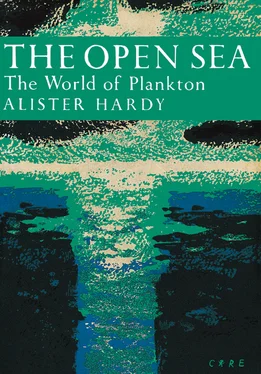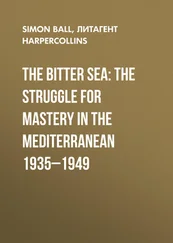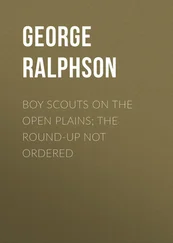In addition there are minor constituents, for example iron, strontium, silicates, phosphates and nitrates, which constitute together only 0.06%. The degree of saltness of the sea, or its salinity , is usually expressed in terms of the total weight of salts in grams per thousand (°/oo) grams of sea-water; it varies in the open ocean from 34°/00 in polar waters, where it is low on account of additions of fresh-water from melting ice, to 37°/00 near the equator where it is high because of excessive evaporation of water. The North Atlantic surface water as it flows round our islands has a salinity of about 35°/00, but in the southern North Sea it is diluted to some 34.5°/00 by water-drainage from the land.
Now the important salts for our little plants are those which have only been mentioned among the minor constituents: they are the phosphates and the nitrates. Because they are present in such small quantities, it was a long time before accurate methods for their estimation could be devised; these were developed largely through the work of Drs. Atkins and Harvey at the Plymouth Laboratory just after the first world war. It had been realised that the plants of the sea must be limited, as are the plants of the land, according to Liebeg’s Minimum Law; i.e. so long as any really essential nutritive substance occurs in minimum quantities, plant production will be proportionate to the available quantities of it, even though there is a super-abundance of all other essentials. This seemed obvious enough but could not be proved until we had these more refined methods. It now became possible to measure the amounts of phosphates and nitrates taken up from the water by the little plants; it was shown that in our waters these salts could and did in fact limit their growth. The reproductive rate of these little plants grown in culture solutions was seen to fall off as the phosphates and nitrates were depleted and finally growth would stop altogether when they were entirely used up.
It is now possible to explain the seasonal cycle of events. In the winter, as we have seen, the waters from top to bottom are well mixed and their temperature is almost uniform. As the length of the days and the intensity of the light increases there comes a point at which the little plants can begin to multiply and they find a comparatively rich supply of phosphates available—about 40 milligrams per cubic metre of water. We have seen how rapidly they undergo fission when once they start. They are multiplying only in the upper, well illuminated zone; in the early spring these upper waters are being well mixed up with the lower layers by the equinoctial gales and there is a general reduction of the free phosphates as they pass into the plants. Presently, however, there develops an upper warm layer which becomes more pronounced as spring advances into summer; this is also the photic zone, in which alone the plants can multiply. The phosphates and nitrates are now being used up by the plants in this upper zone and are not being replaced by any mixing with the lower waters because of the difference in density between them. In fact the phosphates and nitrates are continually passing from the upper to the lower layers. The plants, which have taken up the salts, may either eventually form resting spores and sink, or may just die and sink, or more likely be eaten by the animal members of the plankton; these may themselves just die and sink or in turn be eaten by other larger animals and so on. The nutritive salts which were once present in the upper zones are now by late summer reduced to a minimum; they are carried in the falling bodies to the bottom or still locked up in animal life. Actually a good deal may be excreted back into the water by the animals, 2 but as most of the animals only make comparatively short visits from the lower into the upper layers to feed on the plants at night, most of the excreted phosphates and nitrates will pass into the lower waters. Thus we see that so long as the discontinuity layer lasts, the plants, such as have not been eaten by the animals, are cut off from the richer phosphates and nitrates below. That is why their numbers decline so markedly as the summer advances and why they cannot reproduce at a rate sufficient to counterbalance the inroads made upon their population by the grazing animals. Down below, the supplies of phosphates and nitrates are being to some extent built up again by their return from dead animals broken down by bacterial action. Now, as the summer wanes, the upper layers are cooled again and the autumn equinoctial gales assist in a general mixing; the water richer in phosphates and nitrates is brought up from below towards the surface where once again we have a fertile layer while the sunlight is still strong enough to encourage photosynthesis.
Here at last we have the explanation of that autumnal outburst of phytoplankton which had for so long been such a puzzle. The time of its appearance and the quantity produced vary markedly in different years; it is usually not very long-lived and eventually the population of plants dwindles to a winter minimum as the light gets too weak to allow much active reproduction. The winter gales stir up the water and the nutrient salts are once again more or less evenly spread through the different layers of water. The temperature, too, is more or less uniform; the cycle is complete.
This brief account of the events throughout the year has dealt with the phytoplankton as a whole. If it suggests, as well it might, that all the different kinds of little plankton plants are increasing and declining together, as the seasons come and go, it would be giving a very false picture. There is in truth a succession of different forms which wax and wane in turn within this larger framework. As the summer advances and the quantity of the phytoplankton is declining, the dinoflagellates come to occupy a much more prominent part in the community; in late August species of Ceratium and Peridinium may be much more evident in the fine net samples than the diatoms. At the second autumn outburst the diatoms will swing back into prominence again. Then within these spring and autumn periods of production there is usually a fairly definite order of appearance of different species of diatoms as the weeks go by; not that one kind disappears entirely of course, but after a period of abundance the reproduction falls to a low ebb and the stock is maintained by only a few individuals or by the resting spores already referred to. The intensive work, already referred to ( see here), carried on week by week for fourteen years at Port Erin in the Isle of Man, has furnished us with a mine of information about these detailed seasonal changes at one place; and now the monthly plankton recorder surveys which will be described in the last chapter ( see here) are giving us similar information for a very wide area.
What makes one species give place to another? Why for example should Chaetoceros decipiens give way to Ch. debilis and socialis as the season advances or Rhizosolenia semispina be replaced by Rh. shrubsolei which in turn may leave the stage to Rh. stolterfothii ? Whilst the grazing of the little plankton animals coupled with the reduction of phosphates and nitrates in the upper layers is bringing about the general decline in the planktonic vegetation it can hardly be controlling the rise and fall of the different species. Johnstone, Scott and Chadwick (1924) in discussing this seasonal sequence of species which they found in their long series of tow-nettings at Port Erin, made an important suggestion as to its cause.
“It is known that some bacteria are incapable of producing their typical effects (say in fixing elementary nitrogen from its solution in sea water) if they are present in pure culture. In order to function effectively they must be associated with some other organism which, by itself, cannot produce the effect in question. Probably such symbiotic relationships may exist on the great scale in the sea. The work of Allen and Nelson (1910) on the artificial culture of diatoms suggests this. In mixed cultures there is always a certain succession of species, one attaining its maximum when another has ceased actively to reproduce. The succession of diatom species during the period of the spring growth suggests that something of the same kind occurs in the sea.”
Читать дальше












